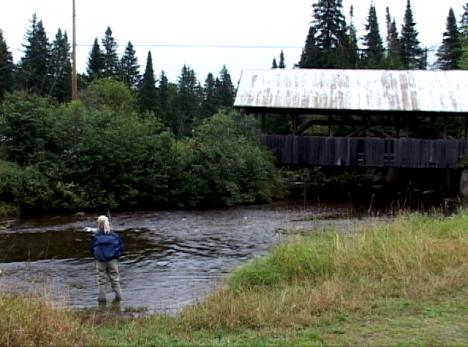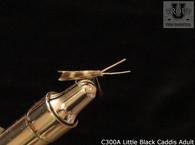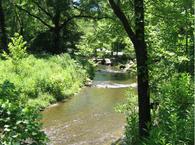
The Connecticut River is the largest river in New England, flowing south from the Connecticut Lakes in northern New Hampshire, along the border between New Hampshire and Vermont, through western Massachusetts and central Connecticut discharging into Long Island Sound. It has a total length of 407 miles, however we are interested in that portion that becomes fishable at the Third Connecticut Lake located off U. S. Highway #3 near the border of Canada.
The Upper Connecticut River and its tributaries provide fly fishers from all over the Northeast with ample opportunity to test their skills. The Eastern Brook Trout and Landlocked Salmon are the only native species, but there are significant populations of rainbow and brown trout. The state record brown was caught in the Upper Connecticut weighing in at 16 pounds and 6 ounces. Unlike many tailwater streams, the Connecticut boasts some very nice aquatic insect hatches including mayflies, stoneflies and caddis flies. These hatches can provide some excellent dry fly fishing conditions.
If you are willing to do some hiking along some old logging trails, the Connecticut River can be fished below the Third Connecticut Lake. Expect to find some nice brook trout hiding in the deeper pools in this area. Fishing from the outlet of the Second Connecticut Lake down to Magalloway Road Bridge will produce some of the larger brookies from the pocket water as well as some land locked salmon. Proceeding downstream, past the First Connecticut Lake, you will find a section of water that is catch-and-release fly fishing only.
Below Lake Francis, the Connecticut is heavily stocked with brook and rainbow trout. The stream is wider with a gravel bottom and is easily waded down to the town of Pittsburg. The Connecticut appears and fishes like a freestone stream, but do not be deceived as you will need to keep an eye on the water levels. The dam discharges water at various levels and caution is the order of the day.
Below the town of Pittsburg, the river becomes deeper and the pools become bigger and longer. The portion of the Connecticut from Pittsburg down to Colebrook is more prone to floating and as a result you will see a large array of canoes, rafts and drift boats.
Fishing the Connecticut:
Start with a 6 weight rod set up and keep some streamers in your fly box as well as the usual flies and terrestrials depending on the season that you are fishing. Note that the scenery is always spectacular in New Hampshire and watch for the Moose crossings.
Spring:
Although the season starts on the first of January, the activity does not start until ice-out which is very late in April or the first of May. The smelt will be running up the river and they will bring the landlocked salmon with them. The main focus may just be the land locked salmon however there will be opportunity to fish for trout at the same time. If you are planning on fishing this early in the year, start with the Blue Winged Olives and the American March Browns. Some streamers will prove to be fatal for some trout as well.
Summer:
The summer season is usually the best time to fish the Connecticut River as the water temperature will remain in the sixties. Start with the Little Black Caddis patterns, followed by the Cinnamon Caddis and the Light Cahills. Dry fly fishing will start in the middle of June and be productive especially with the brook trout well into August.
Autumn:
The fall season is good starting in August with the Sulfur Duns, and the Green Sedges. Also the Cinnamon Caddis will continue to hatch up to the first part of September. Nymphs as will as streamers will be effective but do not neglect to have some terrestrials in your fly box. The fall season ends in October.
Access to the upper portion is from Highway 3 and hiking into the stream on the logging trails. Below the Second Connecticut Lake there is accessibility but the best area for access is below the First Connecticut Lake where there are four points of access.
The trophy section along River Road leading to Lake Francis Park as well as the Park itself will also provide good access. Below the town of Pittsburg, there will be good access along Highway 3.
View New England in a larger map





